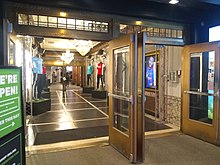Embassy Theatre (New York City)
Designed by Thomas W. Lamb, the theater opened in 1925 on the ground floor of 1560 Broadway, the headquarters of the Actors' Equity Association.While no longer in use as a theater, the space is preserved as a New York City designated landmark, and it continues to operate as a store.The auditorium originally had 598 seats, which were arranged on a single raked floor, facing a proscenium arch with a movie screen.[2] The building is on the east side of Seventh Avenue between 46th and 47th Streets, in the Theater District of Midtown Manhattan in New York City.[12] Above the square mirrors are entablatures with friezes made of burled walnut, as well as gold-colored bas-relief panels with putti and vases.[40] Nineteen years old at the time,[41][42] Gould was described in Exhibitors' Trade Review as "the youngest person, either male or female, to have ever achieved the distinction of directing a modern motion picture theatre, and that in the great metropolis of the world".[41][47] All seats were reserved and cost $2 each (equivalent to $35 in 2023),[42][48][a] as Gould wanted the theater to cater to impatient "society people", rather than the general public.[4][30] Furthering the Embassy's exclusive nature, "beggars, vagrants, peddlers, bootleggers and blind persons" were not allowed to enter.[39] Gould's ushers had to be blondes in their late teens or early twenties,[b] at most 5 feet 4 inches (1.63 m) tall, with white teeth and the "ability to wear clothes with dignity".[46][49][18] Almost four hundred women applied for staff positions, including a "white-haired widow" and a "daughter of a Russian general", according to Gould.[28] The Embassy initially only had two screenings daily:[30][48] one at 2:45 p.m. and the other at 8:45 p.m.[48] By October 1925, the popularity of The Merry Widow had prompted the theater's management to add a third screening on weekends at 6 p.m.[51] Six weeks after the theater opened, Gould traveled to Paris, claiming she needed to "rest" from her "interesting theatrical work";[46][52] however, she subsequently sought legal residence there.[54] Ticket prices had dropped to $0.50 or $1.00, as the concept of reserved seats was no longer novel nor in high demand, especially with the development of larger movie houses.[60] The first newsreel was screened on November 2, 1929, with footage of news items such as the city's 1929 mayoral election debates and the Wall Street Crash.[68] The newsreels were completely changed every week,[69] and the theater was on the heavily traveled Times Square, adding to the Embassy's popularity.[61] By 1930, Movietone's editor E. L. Harvey said the Embassy had "far outgrown its original plans" of being "a show window on Broadway for Fox News".[70] The Embassy's newsreels included the first sound reel of a whale being captured;[71] a tribute to U.S. president Calvin Coolidge;[72] the rise of Adolf Hitler;[73] appearances by Pope Pius XI[74] and J. P. Morgan Jr.[75] and the trial and sentencing of several men who kidnapped oil magnate Charles F.[61][79] Among the newsreel stories shown at the Embassy under Pathé News' operation were Bruno Richard Hauptmann's trial in 1935,[83] as well as a 1938 film on the Nazi Party.[89][91] Under the new policy, the newsreels were changed every Wednesday and Sunday, with a 25-cent admission price between 5 p.m.[89] That April, the Embassy's management considered showing feature films that had won Academy Awards.[88][d] By the 1980s, many of Times Square's cinemas had closed and had been modified or demolished, but the Embassy I remained active, with its architectural details being largely preserved.At the time, the visitor center was housed in the Selwyn Theatre, which was planned to be renovated as part of the 42nd Street redevelopment project.Guild Enterprises' lease on the Embassy was also about to expire, and the single-screen cinema faced competition from two upcoming multiplexes in Times Square: the AMC Empire 25 and a 13-screen Sony Theaters house.[31] The Times Square Information Center's inner lobby had restrooms, a currency exchange, and a booth selling memorabilia from the New York City government.[31][109] The visitor center featured six internet terminals, which were installed as part of a collaboration with Yahoo!,[109][110] There was a newsstand, four Fleet Bank ATMs, and ticket booths operated by the League of American Theatres and Producers, Metropolitan Transportation Authority, the New York City government, and Circle Line Sightseeing Cruises.[18][31][111] The center also contained a display about Times Square's history, narrated by then-mayor Rudy Giuliani and television personality Dick Clark, as well as Winer's mural.[26][114] The owners subsequently made another proposal in October 2013, which involved modifying the basement escalators and leveling the raked auditorium floor; Community Board 5 also opposed this plan.[26][115] The community board approved a third proposal made by Carlton Architects, who represented Brazilian soccer player Pelé, a prospective retail tenant for the space.








ManhattanNew York CityCoordinatesSL GreenCapacityThomas W. LambNew York City Landmarkmovie theaterBroadwayTimes SquareMidtown ManhattanActors' Equity AssociationNew York City designated landmarkcoved ceilingraked floorprosceniumArthur CrispRambusch Decorating CompanyMetro-Goldwyn-MayerGloria Gouldnewsreel theaterNew York City Landmarks Preservation CommissionSeventh Avenue47th StreetsTheater DistrictDuffy SquareI. Miller BuildingTSX BroadwayPalace TheatreActors Equitytransom windowwainscotingfriezemedallionsentablaturesburledbas-reliefwreathscarminedamaskgrotesquecornicebracketsmanualM. P. MöllerfiligreelegitimateC. Howard CraneJohn EbersonBillboardThe Merry WidowMotion Picture NewsnewsreelsMajor BowesAmerican Guild of OrganistsMare NostrumLa BohèmeBen-HurTell It to the MarinesSlide, Kelly, SlideAnnie LaurieSubmarineThe CavalierThe VikingBellamy TrialFather and SonWilliam FoxMovietonewith soundSam H. Harris Theatrecity's 1929 mayoral election debatesWall Street CrashCalvin CoolidgeAdolf HitlerPope Pius XIJ. P. Morgan Jr.Charles F. UrschelPathé NewsBruno Richard HauptmannNazi PartyFranklin D. Rooseveltfireside chatsHerbert J. KrappQuartetThe Hidden RoomAcademy AwardsCassino to KoreaTake a Girl Like YouBattle for the Planet of the ApesNew York City Board of EstimateBusiness Improvement DistrictSelwyn Theatre42nd StreetmultiplexesAMC Empire 25EverGreene Architectural ArtsBrooklyncurrency exchangeYahoo!Fleet BankLeague of American Theatres and ProducersMetropolitan Transportation AuthorityCircle Line Sightseeing CruisesRudy GiulianiDick Clarkoff-Broadwaypeep showsTimes Square BallManhattan Community Board 5soccerList of New York City Designated Landmarks in Manhattan from 14th to 59th StreetsNew York Daily MirrorUpper West SideWhite, NorvalAIA Guide to New York CityDiamonstein-Spielvogel, BarbaraleeState University of New York PressThe New York TimesProQuest1 Times Square3 Times Square4 Times Square5 Times Square7 Times Square (Times Square Tower)11 Times Square20 Times Square